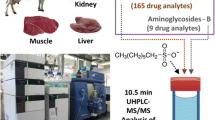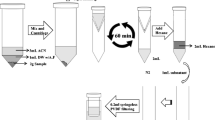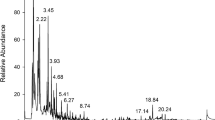Abstract
Veterinary drug residues in animal-derived foods must be monitored to ensure food safety, verify proper veterinary practices, enforce legal limits in domestic and imported foods, and for other purposes. A common goal in drug residue analysis in foods is to achieve acceptable monitoring results for as many analytes as possible, with higher priority given to the drugs of most concern, in an efficient and robust manner. The U.S. Department of Agriculture has implemented a multiclass, multi-residue method based on sample preparation using dispersive solid phase extraction (d-SPE) for cleanup and ultrahigh-performance liquid chromatography–tandem quadrupole mass spectrometry (UHPLC-QQQ) for analysis of >120 drugs at regulatory levels of concern in animal tissues. Recently, a new cleanup product called “enhanced matrix removal for lipids” (EMR-L) was commercially introduced that used a unique chemical mechanism to remove lipids from extracts. Furthermore, high-resolution quadrupole–time-of-flight (Q/TOF) for (U)HPLC detection often yields higher selectivity than targeted QQQ analyzers while allowing retroactive processing of samples for other contaminants. In this study, the use of both d-SPE and EMR-L sample preparation and UHPLC-QQQ and UHPLC-Q/TOF analysis methods for shared spiked samples of bovine muscle, kidney, and liver was compared. The results showed that the EMR-L method provided cleaner extracts overall and improved results for several anthelmintics and tranquilizers compared to the d-SPE method, but the EMR-L method gave lower recoveries for certain β-lactam antibiotics. QQQ vs. Q/TOF detection showed similar mixed performance advantages depending on analytes and matrix interferences, with an advantage to Q/TOF for greater possible analytical scope and non-targeted data collection. Either combination of approaches may be used to meet monitoring purposes, with an edge in efficiency to d-SPE, but greater instrument robustness and less matrix effects when analyzing EMR-L extracts.

Comparison of cleanup methods in the analysis of veterinary drug residues in bovine tissues






Similar content being viewed by others
References
Martinez JL. Environmental pollution by antibiotics and by antibiotic resistance determinants. Environ Pollut. 2009;157(11):2893–902.
Sorum H, L’Abee-Lund TM. Antibiotic resistance in food-related bacteria—a result of interfering with the global web of bacterial genetics. Int J Food Microbiol. 2002;78(1–2):43–56.
Samanidou V, Nisyriou S. Multi-residue methods for confirmatory determination of antibiotics in milk. J Sep Sci. 2008;31(11):2068–90. doi:10.1002/jssc.200700647.
Reig M, Toldrá F. Veterinary drug residues in meat: concerns and rapid methods for detection. Meat Sci. 2008;78(1–2):60–7. doi:10.1016/j.meatsci.2007.07.029.
Kaufmann A. Validation of multiresidue methods for veterinary drug residues; related problems and possible solutions. Anal Chim Acta. 2009;637(1–2):144–55. doi:10.1016/j.aca.2008.09.033.
EC (2006) Directive 2006/122/EC of the European Parliament and of the Council of 12 December 2006. http://eur-lex.europa.eu/LexUriServ/LexUriServ.do?uri=OJ:L:2006:372:0032:0034:en:PDF. Accessed 25 Jan 2017
United States Food and Drug Administration. CFR Title 21—Food and Drugs, Part 556, Tolerances for residues of new animal drugs in food. 2015. http://www.accessdata.fda.gov/scripts/cdrh/cfdocs/cfcfr/cfrsearch.cfm?cfrpart=556. Accessed 25 Jan 2017
Dasenaki ME, Michali CS, Thomaidis NS. Analysis of 76 veterinary pharmaceuticals from 13 classes including aminoglycosides in bovine muscle by hydrophilic interaction liquid chromatography–tandem mass spectrometry. J Chromatogr A. 2016;1452:67–80. doi:10.1016/j.chroma.2016.05.031.
Kaufmann A, Butcher P, Maden K, Widmer M. Quantitative multiresidue method for about 100 veterinary drugs in different meat matrices by sub 2-μm particulate high-performance liquid chromatography coupled to time of flight mass spectrometry. J Chromatogr A. 2008;1194(1):66–79. doi:10.1016/j.chroma.2008.03.089.
Han L, Sapozhnikova Y, Lehotay SJ. Streamlined sample cleanup using combined dispersive solid-phase extraction and in-vial filtration for analysis of pesticides and environmental pollutants in shrimp. Anal Chim Acta. 2014;827:40–6. doi:10.1016/j.aca.2014.04.005.
Amendola G, Pelosi P, Attard Barbini D. Determination of pesticide residues in animal origin baby foods by gas chromatography coupled with triple quadrupole mass spectrometry. J Environ Sci Health-Part B Pestic, Food Contam, Agric Wastes. 2015;50(2):109–20. doi:10.1080/03601234.2015.975607.
Frenich AG, Romero-González R, del Mar Aguilera-Luiz M. Comprehensive analysis of toxics (pesticides, veterinary drugs and mycotoxins) in food by UHPLC-MS. TrAC Trends Anal Chem. 2014;63:158–69. doi:10.1016/j.trac.2014.06.020.
Han L, Sapozhnikova Y, Lehotay SJ. Method validation for 243 pesticides and environmental contaminants in meats and poultry by tandem mass spectrometry coupled to low-pressure gas chromatography and ultrahigh-performance liquid chromatography. Food Control. 2016;66:270–82. doi:10.1016/j.foodcont.2016.02.019.
Aguilera-Luiz MM, Martínez Vidal JL, Romero-González R, Garrido Frenich A. Multiclass method for fast determination of veterinary drug residues in baby food by ultra-high-performance liquid chromatography–tandem mass spectrometry. Food Chem. 2012;132(4):2171–80. doi:10.1016/j.foodchem.2011.12.042.
Zhang Z, Li X, Ding S, Jiang H, Shen J, Xia X. Multiresidue analysis of sulfonamides, quinolones, and tetracyclines in animal tissues by ultra-high performance liquid chromatography–tandem mass spectrometry. Food Chem. 2016;204:252–62. doi:10.1016/j.foodchem.2016.02.142.
Kinsella B, O’Mahony J, Malone E, Moloney M, Cantwell H, Furey A, et al. Current trends in sample preparation for growth promoter and veterinary drug residue analysis. J Chromatogr A. 2009;1216(46):7977–8015. doi:10.1016/j.chroma.2009.09.005.
Schneider MJ, Lehotay SJ, Lightfield AR. Validation of a streamlined multiclass, multiresidue method for determination of veterinary drug residues in bovine muscle by liquid chromatography–tandem mass spectrometry. Anal Bioanal Chem. 2015;407:4423–35. doi:10.1007/s00216-014-8386-3.
Lehotay SJ. QuEChERS sample preparation approach for mass spectrometric analysis of pesticide residues in foods. Methods in Molecular Biology. 2011;747:65–91. doi:10.1007/978-1-61779-136-9_4.
Stubbings G, Bigwood T. The development and validation of a multiclass liquid chromatography tandem mass spectrometry (LC–MS/MS) procedure for the determination of veterinary drug residues in animal tissue using a QuEChERS (QUick, Easy, CHeap, Effective, Rugged and Safe) approach. Anal Chim Acta. 2009;637(1–2):68–78. doi:10.1016/j.aca.2009.01.029.
Zhao L. Benefits of EMR-lipid cleanup with enhanced post treatment on pesticides analysis by GC/MS/MS. Agilent Application Note 5991-6707EN. 2015.
Han L, Matarrita J, Sapozhnikova Y, Lehotay SJ. Evaluation of a recent product to remove lipids and other matrix co-extractives in the analysis of pesticide residues and environmental contaminants in foods. J Chromatogr A. 2016;1449:17–29. doi:10.1016/j.chroma.2016.04.052.
López-Blanco R, Nortes-Méndez R, Robles-Molina J, Moreno-González D, Gilbert-López B, García-Reyes JF, et al. Evaluation of different cleanup sorbents for multiresidue pesticide analysis in fatty vegetable matrices by liquid chromatography tandem mass spectrometry. J Chromatogr A. 2016;1456:89–104. doi:10.1016/j.chroma.2016.06.019.
Zhao L, Lucas D. Multiresidue analysis of veterinary drugs in bovine liver by LC/MS/MS. Agilent Application Note (5991–6096). 2015
Stolker AAM, Brinkman UAT. Analytical strategies for residue analysis of veterinary drugs and growth-promoting agents in food-producing animals—a review. J Chromatogr A. 2005;1067(1–2):15–53. doi:10.1016/j.chroma.2005.02.037.
Geis-Asteggiante L, Lehotay SJ, Lightfield AR, Dutko T, Ng C, Bluhm L. Ruggedness testing and validation of a practical analytical method for >100 veterinary drug residues in bovine muscle by ultrahigh performance liquid chromatography–tandem mass spectrometry. J Chromatogr A. 2012;1258:43–54. doi:10.1016/j.chroma.2012.08.020.
Yamada R, Kozono M, Ohmori T, Morimatsu F, Kitayama M. Simultaneous determination of residual veterinary drugs in bovine, porcine, and chicken muscle using liquid chromatography coupled with electrospray ionization tandem mass spectrometry. Biosci Biotechnol Biochem. 2006;70(1):54–65. doi:10.1271/bbb.70.54.
Park JA, Zhang D, Kim DS, Kim SK, Cho KS, Jeong D, et al. Single-step multiresidue determination of ten multiclass veterinary drugs in pork, milk, and eggs using liquid chromatography with tandem mass spectrometry. J Sep Sci. 2015;38(16):2772–80. doi:10.1002/jssc.201500501.
Staub Spörri A, Jan P, Cognard E, Ortelli D, Edder P. Comprehensive screening of veterinary drugs in honey by ultra-high-performance liquid chromatography coupled to mass spectrometry. Food Addit Contam: Part A. 2014;31(5):806–16. doi:10.1080/19440049.2014.891295.
Ortelli D, Cognard E, Jan P, Edder P. Comprehensive fast multiresidue screening of 150 veterinary drugs in milk by ultra-performance liquid chromatography coupled to time of flight mass spectrometry. J Chromatogr B. 2009;877(23):2363–74. doi:10.1016/j.jchromb.2009.03.006.
Geis-Asteggiante L, Nuñez A, Lehotay SJ, Lightfield AR. Structural characterization of product ions by electrospray ionization and quadrupole time-of-flight mass spectrometry to support regulatory analysis of veterinary drug residues in foods. Rapid Commun Mass Spectrom. 2014;28(10):1061–81. doi:10.1002/rcm.6871.
Wang J, Leung D, Chow W, Chang J, Wong JW. Development and validation of a multiclass method for analysis of veterinary drug residues in milk using ultrahigh performance liquid chromatography electrospray ionization quadrupole Orbitrap mass spectrometry. J Agric Food Chem. 2015;63(41):9175–87. doi:10.1021/acs.jafc.5b04096.
Turnipseed SB, Storey JM, Clark SB, Miller KE. Analysis of veterinary drugs and metabolites in milk using quadrupole time-of-flight liquid chromatography–mass spectrometry. J Agric Food Chem. 2011;59(14):7569–81. doi:10.1021/jf103808t.
Anumol T, Stevens J, Yang D-HD, Zweigenbaum JA. Analysis of 122 veterinary drugs in meat using all ions MS/MS with an Agilent 1290/6545 UHPLC-Q-TOF system. Agilent Application Note 5991-6651EN. 2016.
Lehotay SJ, Lightfield AR, Geis-Asteggiante L, Schneider MJ, Dutko T, Ng C, et al. Development and validation of a streamlined method designed to detect residues of 62 veterinary drugs in bovine kidney using ultra-high performance liquid chromatography–tandem mass spectrometry. Drug Testing Anal. 2012;4(Suppl. 1):75–90. doi:10.1002/dta.1363.
Zhao L, Lucas D. Multiresidue analysis of pesticides in avocado with Agilent Bond Elut EMR—lipid by GC/MS/MS. Agilent Application Note 5991-6097EN. 2015.
Lucas D, Zhao L. PAH analysis in salmon with enhanced matrix removal. Agilent Application Note 5991-6088EN. 2015.
Stahnke H, Kittlaus S, Kempe G, Alder L. Reduction of matrix effects in liquid chromatography–electrospray ionization–mass spectrometry by dilution of the sample extracts: how much dilution is needed? Anal Chem. 2012;84(3):1474–82. doi:10.1021/ac202661j.
Kwon H, Lehotay SJ, Geis-Asteggiante L. Variability of matrix effects in liquid and gas chromatography–mass spectrometry analysis of pesticide residues after QuEChERS sample preparation of different food crops. J Chromatogr A. 2012;1270:235–45. doi:10.1016/j.chroma.2012.10.059.
Banerjee S, Mazumdar S. Electrospray ionization mass spectrometry: a technique to access the information beyond the molecular weight of the analyte. Int J Anal Chem. 2012;2012:40. doi:10.1155/2012/282574.
Martínez Vidal JL, Frenich AG, Aguilera-Luiz MM, Romero-González R. Development of fast screening methods for the analysis of veterinary drug residues in milk by liquid chromatography-triple quadrupole mass spectrometry. Anal Bioanal Chem. 2010;397(7):2777–90. doi:10.1007/s00216-009-3425-1.
Mastovska K, Lightfield AR. Streamlining methodology for the multiresidue analysis of β-lactam antibiotics in bovine kidney using liquid chromatography–tandem mass spectrometry. J Chromatogr A. 2008;1202(2):118–23. doi:10.1016/j.chroma.2008.07.009.
Aldeek F, Canzani D, Standland M, Crosswhite MR, Hammack W, Gerard G, et al. Identification of penicillin G metabolites under various environmental conditions using UHPLC-MS/MS. J Agric Food Chem. 2016;64(31):6100–7. doi:10.1021/acs.jafc.5b06150.
Anastassiades M, Lehotay SJ, Štajnbaher D, Schenck FJ. Fast and easy multiresidue method employing acetonitrile extraction/partitioning and “dispersive solid-phase extraction” for the determination of pesticide residues in produce. J AOAC Int. 2003;86(2):412–31.
Schneider MJ, Lehotay SJ, Lightfield AR. Evaluation of a multi-class, multi-residue liquid chromatography–tandem mass spectrometry method for analysis of 120 veterinary drugs in bovine kidney. Drug Testing Anal. 2012;4(Suppl. 1):91–102. doi:10.1002/dta.1359.
Acknowledgements
We thank Alan Lightfield at USDA-ARS for technical assistance in the laboratory. The authors also acknowledge Limian Zhao and Derrick Lucas from Agilent Technologies for fruitful discussions during the project.
Author information
Authors and Affiliations
Corresponding author
Ethics declarations
Conflict of interest
The authors declare that they have no conflict of interest.
Additional information
Mention of brand or firm name does not constitute an endorsement by the U.S. Department of Agriculture above others of a similar nature not mentioned. USDA is an equal opportunity provider and employer.
Electronic supplementary material
Below is the link to the electronic supplementary material.
ESM 1
(PDF 885 kb)
Rights and permissions
About this article
Cite this article
Anumol, T., Lehotay, S.J., Stevens, J. et al. Comparison of veterinary drug residue results in animal tissues by ultrahigh-performance liquid chromatography coupled to triple quadrupole or quadrupole–time-of-flight tandem mass spectrometry after different sample preparation methods, including use of a commercial lipid removal product. Anal Bioanal Chem 409, 2639–2653 (2017). https://doi.org/10.1007/s00216-017-0208-y
Received:
Revised:
Accepted:
Published:
Issue Date:
DOI: https://doi.org/10.1007/s00216-017-0208-y




